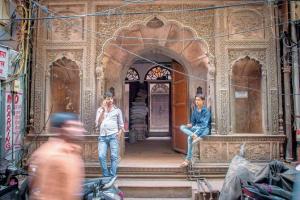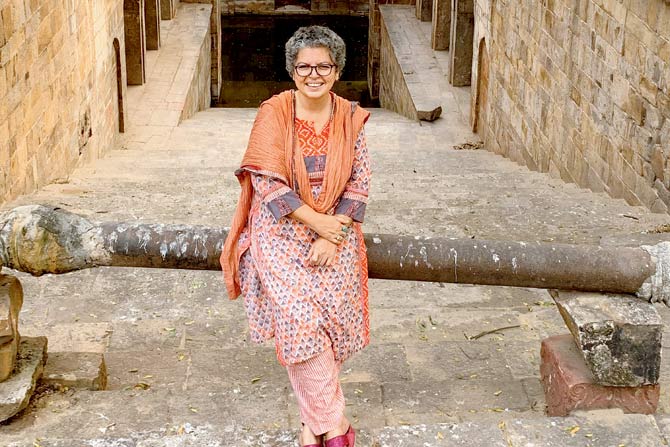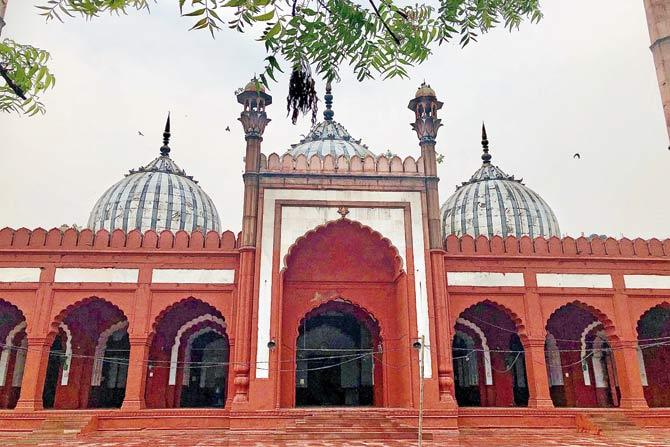Historian Rana Safvi flips pages of her new book on Shahjahanabad to discuss hidden gems of the old neighbourhood worth exploring on your next trip to the capital

A view of an old haveli in the walled city of Old Delhi. Pic/ Getty Images
Old Delhi was a city built for horses, carriages and a gentler life, says historian Rana Safvi, as she draws us into the charms of rundown monuments that continue to warm her heart.
Once known as Shahjahanabad—after Mughal Emperor Shah Jahan who built it in 1639—and home to several fifth and sixth generation residents, all of whom Safvi describes as "keepers of its history," the city today, she says, is far removed from the vision of its chief architect. "Shah Jahan was a prolific builder. When he gave orders to build a new city, he envisaged a magnificent place on the theme of paradise, built on the banks of the River Yamuna. It was also a planned city with specific areas allocated according to trade, profession and hierarchy. Land was allotted for havelis, gardens, bazaars and religious buildings. This city bore the brunt of the revolt of 1857 when the British looted the nobility, banished residents and rearranged the city for administrative purposes," says the historian. The commercialisation and shortage of residential space however, has resulted in the havelis being broken and turned into flats, or warehouses.
Yet, Safvi continues to be an admirer. Her romance with Old Delhi first began, when she undertook the translations of Dastan-e-Ghadar by Zahir Dehlvi, who was a poet in the court of Bahadur Shah Zafar, and Sir Syed Ahmad Khan's account of the city in Asar-us-Sanadid. "Each time I visited the place, I found something exciting." Safvi dips into her new book, Shahjahanbad: The Living City of Old Delhi (HarperCollins India), her final installment in an illustrated series on Delhi, for a walk through the forgotten histories of places and people.
Sawan aur Bhado'n, Lal Qila
According to Safvi, it took nine years to build the qila (1639-48 AD). "The city was built alongside, but work continued on it for longer," she says. Most of the buildings in the qila were destroyed after the uprising of 1857. "In the book, I have described my disappointment on seeing some of the buildings, especially Imtiaz Mahal after reading Sir Syed Ahmad Khan's lyrical prose in its praise. One set of rooms, which still retain some semblance of beauty is the Hammam complex, but is out of bounds for the tourist."
 The Sawan Pavillion. Pics/ Rana Safvi
The Sawan Pavillion. Pics/ Rana Safvi
Till then, Safvi suggests roaming between the Sawan and Bhado'n, two buildings named eponymously after the monsoon months, which recreated the effect of rain. While no water flows in or out of these, as all the holes and fountains are choked, Safvi says its magic can still be experienced, if you keep an open mind.
 Rana Safvi. Pic/ Dhaminder Bhat
Rana Safvi. Pic/ Dhaminder Bhat
Mir Panjakash ki Haveli

Calligrapher and arm wrestler Mir Panjakash, whose real name was Syed Mohammad Amir, was an important personality of his era and a contemporary of Bahadur Shah Zafar, says Safvi. "His hand was very delicate when doing calligraphy and he had an iron grip as an arm wrestler, thus the nickname Panjakash." His haveli occupied the entire slope of Pahari Imli Mohalla in Shahjahanabad. He was killed by British soldiers after the uprising of 1857 and buried in his house. "Today, there are small workshops, tenants and a school that function out of the haveli. I explored most of Shahjahanabad with my friend Abu Sufiyan. One day, as luck would have it, the entrance to the room where his grave is situated was open and the tenant allowed us inside," she says. While it is impossible to get access to the grave, Safvi suggests you try your luck anyway.
Chah Rahat or Well with Persian Wheel

In earlier times, water for the ablution pool in Jama Masjid was supplied by a well, using a Persian Wheel. There is old doorway in Chandni Chowk, behind which the well and wheel apparatus is located. The well building, however, is now dark. "After the partition of India in 1947, many of the areas here were populated by refugees. One can't really blame a displaced person for prioritising the rebuilding of their own life over the remains of the past, whose history they probably didn't even know. Now there are families living in the small area adjoining the well room and the door to the well is kept locked," says Safvi. The place is, however, still called Chah (Well) Rahat.
Zeenat-ul Masjid

While much has been written about the grandiosity of Jama Masjid, Safvi's favourite is the Zeenat-ul Masjid that was built by Aurangzeb's daughter Zeenat-un Nisa Begum. Built completely of red sandstone, this structure was based on the design of the Jama Masjid. "The black stripes on the domes gave it the nickname Ghata Masjid (ghata meaning clouds)," she says. The princess built her tomb within the enclosure of the mosque during her lifetime, and she was buried here in 1721. "After the failed 1857 revolt, the British confiscated the mosque and turned it into a bakery . The tomb was also destroyed and the grave levelled to the ground. It was rebuilt later on the southern end of the mosque. To me, this beautiful mosque symbolises the spirit of resurgence," she says.
When in Old Dehi

Getting around: Safvi prefers walking to explore the city. "The roads here are narrow, bumpy and uneven, so avoid travelling in a vehicle. A rickshaw is also convenient." Hiring a rickshaw for an entire day costs Rs 500, if you bargain well.
What to eat: You might want to ignore hygiene, while binging on kebab, nihari and biryani at road-side stalls in Matia Mahal and Chitli Qabr Bazaar. The recipes have come down generations. Safvi's top picks are Kallu, Pahalwan ki Biryani and Babu Kababwala. The kebabs sell at R10 per piece, and nihari between Rs 50 and Rs 100 per plate.
To shop and explore: Bulbulikhana near Turkman Darwaza is famous for its wholesale jewellery, beads and handicrafts. "This area predates Shahjahanabad and was part of the fifth city of Delhi. In its narrow lanes is the grave of Delhi's only female monarch, Razia Sultana," says Safvi.
1639
The year Mughal Emperor Shah Jahan built the city of Shahjahanabad
Want to hear from you
We are looking to visit and write about interesting places of stay and travel, near and far. If you wish to host us for a fair, engaging experience review, write to us at smdmail@mid-day.com
Catch up on all the latest Mumbai news, crime news, current affairs, and also a complete guide on Mumbai from food to things to do and events across the city here. Also download the new mid-day Android and iOS apps to get latest updates
 Subscribe today by clicking the link and stay updated with the latest news!" Click here!
Subscribe today by clicking the link and stay updated with the latest news!" Click here!









